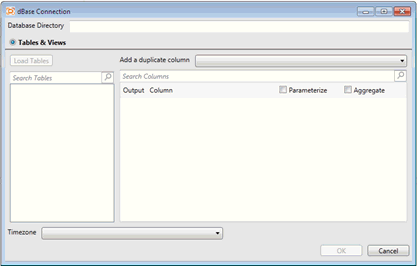dBase (32-bit Only)
The dBase connector allows you to connect to dBase drivers.
Using dBase
-
When creating a new data table, select dBase from the Connect to Data dialog.
The dBase Connection dialog is displayed.

-
Provide the location of the Database Directory.
-
The easiest way to select a table and/or view to load is by choosing from a set of predefined tables and views. To do so, ensure that the Tables & Views button is selected. Once either a table or view has been selected, the OK button at the bottom of the dialog is enabled.
-
Click Load Tables to load a list of predefined tables or views. This list can be filtered by entering an appropriate string in the Search Tables search box.
You can also add a duplicate column.
-
Select a table to display the available columns in the Search Columns list.
-
Select the columns to add to your data table by checking their corresponding Output Column box.
-
If you wish to parameterize a specific column, check the Parameterize checkbox and, in the dropdowns that display, select the desired value.
-
If the data returned is to be aggregated, check the Aggregate checkbox. The following aggregation methods are possible:
-
-
Text Columns: Group By
-
Date Columns: Count, Min, Max, Group By
-
Numeric Columns: Sum, Count, Min, Max, Group By.
-
The time zone of input parameters and output data is, by default, unchanged. Changing the time zone is supported by using the Timezone list box based on the assumption that data are stored in UTC time and outputs are presented in the selected time zone.
-
Click OK to confirm the selection and retrieve the record set into Designer.
The flat record set corresponding to the executed SQL is returned from the source database and displayed in Data Prep with the database name as the title and all fields listed displayed in Data Source Preview.
-
If you wish to make changes to your fields, you may do so now and then click OK when you are finished. If you do not wish to make any changes to your data, simply select the OK button.